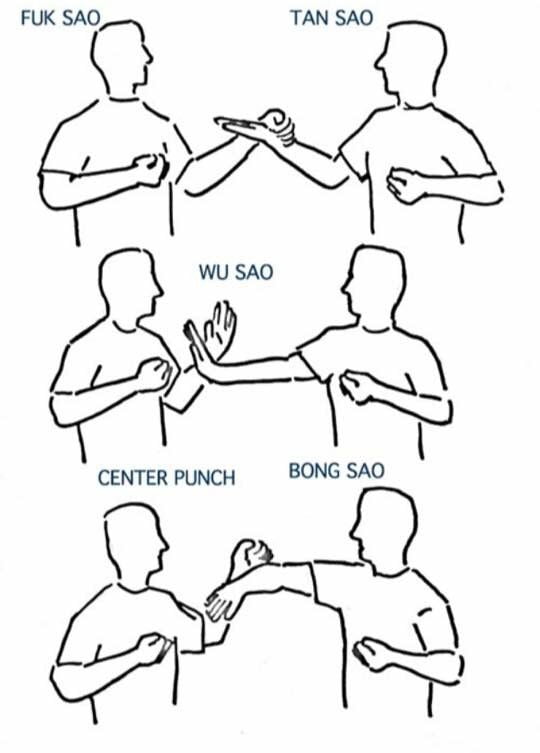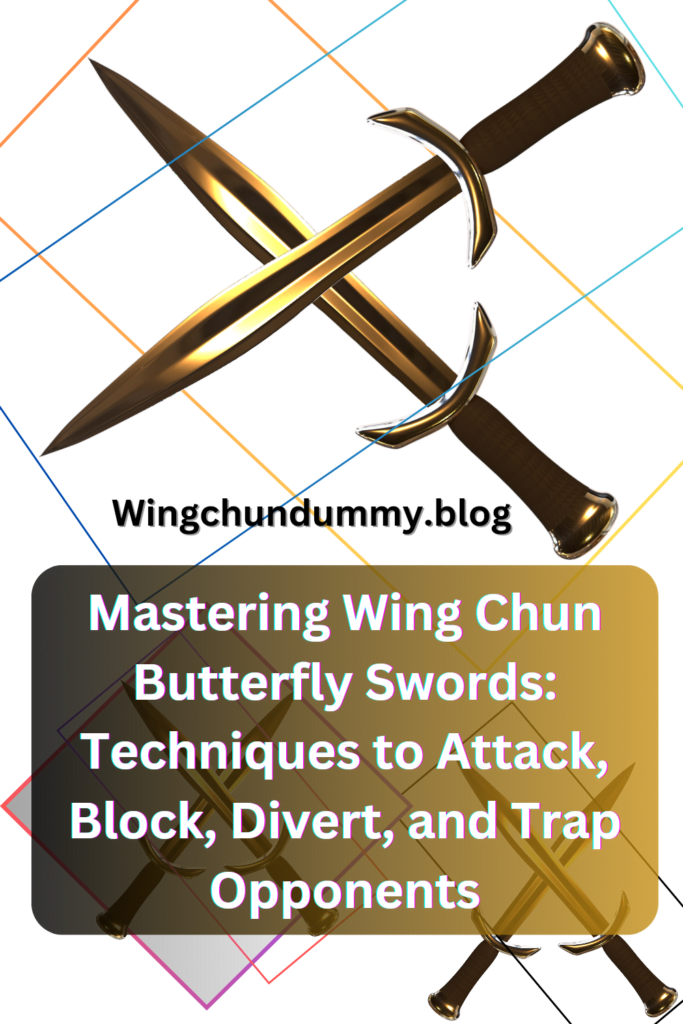Mastering Butterfly 🦋 Swords, ⚔️ known in Cantonese as ‘Baat Jaam Do,’ hold a significant place in the traditional martial arts of Wing Chun.
These short swords, typically ranging from 12 to 15 inches in length, are designed for close-quarters combat, offering practitioners an effective combination of offensive and defensive capabilities.
Historically, the Butterfly Swords have been an essential tool in the Wing Chun arsenal, symbolizing both the practical and philosophical aspects of this martial art.
Originating from Southern China, the Butterfly Swords were initially used by civilians and martial artists who needed a versatile weapon for self-defense.
The compact design of these swords allowed for swift and agile movements, making them exceptionally effective in confined spaces.
Unlike longer swords, which require more room to maneuver,
the Butterfly Swords excel in tight quarters, where quick reflexes and precise strikes are paramount.
The design of the Butterfly Swords is unique, featuring a flat, wide blade with a single cutting edge and a blunt back edge.
This configuration enables the wielder to deliver powerful slashing attacks while also allowing for effective blocking and trapping techniques.
The hilt often includes a handguard that protects the user’s hand during combat, further enhancing the sword’s defensive capabilities.
In Wing Chun practice, the Butterfly Swords are used to hone a practitioner’s skills in timing, coordination, and precision.
They are an extension of the empty-hand techniques, translating the principles of deflection, redirection, and trapping into weaponized forms.
The swords’ ability to both attack and defend simultaneously embodies the core philosophy of Wing Chun: efficiency and economy of movement.
Overall, the Wing Chun Butterfly Swords are more than just weapons; they are an integral part of the martial artist’s journey toward mastery.
Their historical significance, unique design, and practical application in close-quarters combat make them a fascinating subject of study for anyone interested in the art of Wing Chun.
The mastery of Wing Chun Butterfly Swords begins with a thorough understanding of the fundamental grips and stances.
Proper hand positioning and body alignment are crucial, as they provide the necessary foundation for executing techniques with precision and effectiveness.
The grip on the Butterfly Swords is typically firm yet flexible, allowing for a balanced control that can swiftly transition between offensive and defensive maneuvers.
The handle should be held in a manner that the thumb and index finger form a secure ring, while the remaining fingers wrap around, providing stability and dexterity.
One of the primary stances in Wing Chun is the Bai Jong stance, which is essential for maintaining a strong defensive position while being ready to launch an attack.
In this stance, the practitioner’s body is slightly turned to the side, minimizing exposure to the opponent.
The feet are positioned shoulder-width apart, with the toes pointing slightly inward.
The knees are bent, and the body weight is distributed evenly across both legs.
This stance not only enhances stability but also enables quick lateral movements, which are vital for both offense and defense.
Another critical stance is the Front Stance, which is used to generate power in forward attacks.
In this position, one foot is placed forward, and the other foot is kept back, forming a strong base.
The front knee is bent, providing both support and momentum for strikes, while the rear leg remains straight but not locked, allowing for immediate transition into different movements.
This stance is particularly effective for launching powerful thrusts and maintaining balance during rapid engagements.
These foundational elements — the proper grip and the fundamental stances such as the Bai Jong and Front Stance — significantly contribute to a practitioner’s ability to effectively wield the Butterfly Swords.
Mastery of these basics ensures that the swordsman can fluidly switch between attacking, blocking, diverting, and trapping opponents, thus forming the cornerstone of proficient Wing Chun Butterfly Sword techniques.
Offensive Techniques: Strikes and Slashes
Butterfly Swords, known for their versatility and efficiency, offer a range of offensive techniques that are fundamental to mastering this weapon.
These techniques include straight thrusts, diagonal slashes, and horizontal cuts, each with unique mechanics and target areas that demand precision and speed.
One of the primary offensive techniques is the straight thrust.
This move involves extending the blade directly towards the opponent, aiming for critical areas such as the abdomen or throat.
The key to executing a successful straight thrust lies in maintaining a firm grip and aligning the body to generate maximum force while minimizing exposure to counter-attacks.
Practicing this technique with a focus on accuracy and speed can significantly enhance its effectiveness.
Diagonal slashes are another essential offensive maneuver with Butterfly 🦋 Sword ⚔️.
These slashes are executed by bringing the sword from a high position downwards at an angle, targeting areas like the shoulder, neck, or torso.
The diagonal motion allows for a combination of power and reach, making it a crucial technique in both offensive and defensive scenarios.
To master diagonal slashes, practitioners should engage in repetitive drills that emphasize fluid motion, control, and the ability to transition smoothly between strikes.
Horizontal cuts involve sweeping the blade in a horizontal arc, targeting the midsection or limbs of the opponent.
This technique requires impeccable timing and precision to avoid overextending and leaving oneself vulnerable.
Horizontal cuts can be particularly effective in close-quarter combat.
where the ability to strike quickly and accurately is paramount.
Drills focusing on the coordination between the upper body and the positioning of the feet are vital for mastering this technique.
To practice these offensive techniques, various drills and exercises can implement.
Shadow fencing, where practitioners mimic the motions of strikes and slashes without an opponent, allows for the refinement of form and technique.
Partner drills, involving controlled sparring sessions, help in developing timing and reaction speed.
Additionally, incorporating resistance training, such as using weighted swords, can build the necessary strength and endurance required for executing powerful and precise attacks.
By dedicating time to these drills and understanding the mechanics behind each offensive technique.
practitioners can significantly improve their proficiency with Butterfly Swords, making them formidable in both training and real-world applications.

Defensive Techniques: Blocks and Parries
In the realm of Wing Chun, the Butterfly Swords are renowned not just for their offensive capabilities but also for their exceptional defensive utility.
Mastering defensive maneuvers, such as blocks and parries, is essential for any practitioner aiming to neutralize an opponent’s attack effectively.
These techniques hinge on precise angles, appropriate positioning, and impeccable timing.
Blocks with Butterfly Swords are primarily executed by aligning the blades to create a defensive bareer 🚧.
A crucial aspect of this technique is the orientation of the swords.
They should be angled outward to deflect incoming strikes, rather than absorbing the full impact.
This approach ensures that the force of the attack is redirectes away from the defender, minimizing potential harm.
For instance, when faced with a direct strike, positioning the swords in a cross formation can effectively halt the attack, providing ample opportunity for counteraction.
Parries, on the other hand, demand a more dynamic approach.
Unlike static blocks, parries involve a fluid motion to redirect the opponent’s weapon away from the intended target.
This technique leverages the Butterfly Swords’ agility, allowing practitioners to maintain a continuous flow in their defensive strategy.
The key lies in subtle wrist movements that guide the opponent’s strike off-course.
A well-executed parry not only neutralizes the attack but also opens avenues for immediate counterstrikes.
Effective blocking and parrying are underpinned by meticulous attention to angles and positioning.
The defender must maintain a balanced stance.
Ensuring that the swords are always within a protective arc around the body.
This readiness allows for swift transitions between offensive and defensive movements.
Additionally, the defender should practice maintaining a low center of gravity, which enhances stability and reduces vulnerability.
Timing and reflex development are paramount in mastering these defensive techniques.
Regular drills focused on reaction speed can significantly improve one’s ability to respond to sudden attacks.
Utilizing training partners to simulate unpredictable strikes can also aid in honing reflexes.
Consistent practice embeds these responses into muscle memory.
Enabling practitioners to execute blocks and parries instinctively in high-pressure scenarios.
Diverting and Redirecting Attacks
Mastering the art of diverting and redirecting attacks with Wing Chun Butterfly Swords requires a deep understanding of using an opponent’s force to your advantage.
The fundamental principle lies in harnessing the momentum of the attack and altering its trajectory, rather than meeting it with direct resistance.
This approach minimizes the energy expended by the defender and maximizes the effectiveness of the redirection.
Fluidity is paramount in these techniques.
The ability to seamlessly transition between movements allows practitioners to maintain control over the engagement and effectively neutralize incoming strikes.
One of the core methods for achieving this is through the ‘Tan Do’ and ‘Gan Do’ techniques.
The ‘Tan Do’ technique involves positioning the swords to create a deflective surface.
guiding the opponent’s weapon or strike away from its intend path.
By using a slight angle, the practitioner can divert the attack with minimal effort.
With maintaining the flow of movement and preparing for a counter-strike.
This method is especially effective against linear or direct attacks.
turning the energy of the strike into a harmless trajectory.
Similarly, the ‘Gan Do’ technique focuses on redirecting attacks by cutting across the line of the incoming force.
This maneuver involves a quick, slicing motion that not only deflects the opponent’s weapon but also positions the practitioner for an offensive follow-up.
The key to ‘Gan Do’ lies in its precision and timing;.
a well-executed cut can disrupt the opponent’s balance and open opportunities for counterattacks.
Incorporating these techniques into practice requires consistent training and a keen sense of timing.
Drills that emphasize fluid transitions and controlled redirections can help practitioners internalize the mechanics of ‘Tan Do’ and ‘Gan Do’. Over time.
These skills become second nature, enabling Wing Chun Butterfly Sword practitioners to effectively manage and neutralize their opponent’s attacks with grace and efficiency.
Trapping Techniques with Butterfly Swords
Trapping techniques play a pivotal role in mastering the art of Butterfly Swords, offering a sophisticate means to control an opponent’s movements.
The essence of trapping lies in immobilizing or redirecting the opponent’s weapon or limbs.
thereby creating strategic openings for counterattacks.
Utilizing Butterfly Swords for trapping requires precision and a deep understanding of the principles behind techniques like ‘Lop Sao’ and ‘Pak Sao’.

‘Lop Sao,’ or “grabbing hand,” is a fundamental technique where one uses the Butterfly Swords to seize and pull the opponent’s weapon or limb.
This action disrupts the opponent’s balance and positioning.
making them vulnerable to subsequent strikes.
When executed correctly, ‘Lop Sao’ allows the practitioner to maintain control and dictate the flow of the encounter.
Practice drills for ‘Lop Sao’ typically involve partner exercises where one participant simulates an attack.
and the other uses the Butterfly Swords to effectively trap and neutralize the threat.
Another essential trapping technique is ‘Pak Sao,’ or “slapping hand,”
which involves using the flat of the Butterfly Sword to parry and redirect the opponent’s attack.
The goal of ‘Pak Sao’ is to deflect the incoming strike while simultaneously closing the distance to launch a counterattack.
This technique is particularly effective in close-quarter combat.
Where swift and decisive movements can turn the tide of a confrontation.
Training for ‘Pak Sao’ includes repetitive blocking and redirecting drills, emphasizing fluidity and precision.
To master these trapping techniques, practitioners should engage in scenario-based training drills.
For instance, a common drill involves alternating between offensive and defensive roles.
focusing on seamlessly integrating ‘Lop Sao’ and ‘Pak Sao’ maneuvers.
By rehearsing these scenarios, one can develop a keen sense of timing and adaptability, essential traits for effective trapping with Butterfly Swords.
Incorporating these trapping techniques into regular practice not only enhances proficiency with Butterfly Swords but also builds a comprehensive skill set for self-defense and combat situations.
The ability to control an opponent’s movements through trapping is a testament to the intricate and disciplines nature of Wing Chun Butterfly Swords mastery.
Combining Techniques for Effective Combat
Mastering Wing Chun Butterfly Swords requires a seamless integration of offensive, defensive, diverting, and trapping techniques to form a cohesive combat strategy.
The key to effective combat lies in adaptability and situational awareness.
recognizing the right moment to switch between attacking and defending is crucial.
This kind of fluidity ensures that practitioners can respond to their opponent’s moves with precision and efficiency.
A straightforward example of combining techniques involves starting with a defensive block, transitioning to a diversion.
and concluding with an offensive strike.
For instance, when facing an incoming attack, a practitioner might use a cross block to intercept the opponent’s weapon.
immediately follow by a diverting technique such as a circular deflection to redirect the opponent’s blade away from the centerline.
With the opponent’s weapon out of the way, the practitioner can then execute a swift counterattack.
Such as a horizontal slash to an exposed target area.
Another effective combination is integrating trapping with offensive strikes.
During sparring, if an opponent’s weapon is momentarily immobilize.
A Wing Chun practitioner can trap the opponent’s arm or weapon using one of the Butterfly Swords.
This trapping action creates an opening, allowing for a quick, decisive strike with the free hand or sword.
Sequences like these illustrate how trapping can transition seamlessly into offensive maneuvers.
Maintaining the flow of combat and keeping the opponent on the defensive.

Continuous practice and refinement of these combinations are essential.
Practitioners should engage in regular sparring sessions to develop their timing and responsiveness.
Situational drills can also help in honing the ability to adapt techniques based on the opponent’s actions.
By persistently working on integrating these elements.
One can develop a more intuitive and effective combat strategy with Wing Chun Butterfly Swords.
Training and Conditioning for Butterfly Swords Mastery
Mastering the use of Wing Chun Butterfly Swords requires a comprehensive approach to both physical and mental training.
Physical conditioning is paramount, as wielding these weapons demands considerable strength, speed, and agility.
Practitioners should incorporate a variety of conditioning exercises into their routine to enhance these attributes.
Strength training can include resistance exercises such as heavy lunges, squats, and push-ups, targeting the muscles used in sword handling and footwork.
Speed and agility can be improve through plyometric drills, ladder drills, and interval training.
Which simulate the quick movements requires in combat scenarios.
Equally important is the need for regular practice sessions to develop muscle memory and refine techniques.
These sessions should always begin with a proper warm-up to prevent injury and prepare the body for the intense activity ahead.
Dynamic stretches, such as arm circles and leg swings, can help increase blood flow to the muscles and improve range of motion.
After practice, cooldown exercises, including static stretching and deep breathing, are crucial for aiding muscle recovery and maintaining flexibility.
In addition to physical conditioning, mental training plays a vital role in mastering Butterfly Swords.
Focus and strategic thinking are essential for effectively applying techniques in real-time situations.
Meditation and visualization exercises can enhance concentration and mental clarity.
Allowing practitioners to remain calm and compose under pressure.
Reaction time can hone through drills that require quick decision-making and swift responses to changing scenarios.
For those seeking further development, numerous resources are available.
- Instructional videos
- online courses
- and workshops
led by experience martial artists can provide valuable insights and advance techniques.
Reading materials on the philosophy and history.
Wing Chun can also enrich one’s understanding and appreciation of the art form.
Consistent practice, combined with a balanced approach to physical and mental training.
It is essential for achieving mastery in Wing Chun Butterfly Swords.
By dedicating time and effort to conditioning and mental preparation.
Practitioners can elevate their skills and become proficient in this dynamic martial art.


